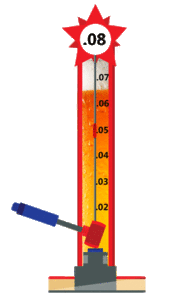 Utah has long been tough on DUI drivers. Now the state has officially lowered the DUI BAC limit, meaning more people will be held criminally accountable for dangerous driving. In 2014, the CDC reports, 9,967 people were killed in alcohol-impaired crashes, which was 31 percent of all traffic-related deaths in the United States. Evidence suggests that one drink can have a detrimental effect on driving. Gov. Herbert posted to Twitter a 2001 scientific review by the National Institute on Alcohol Abuse and Alcoholism that found, A large body of credible research over many years has clearly shown that impairment of tasks necessary for safe driving begins at levels as low as 0.05 percent.
Utah has long been tough on DUI drivers. Now the state has officially lowered the DUI BAC limit, meaning more people will be held criminally accountable for dangerous driving. In 2014, the CDC reports, 9,967 people were killed in alcohol-impaired crashes, which was 31 percent of all traffic-related deaths in the United States. Evidence suggests that one drink can have a detrimental effect on driving. Gov. Herbert posted to Twitter a 2001 scientific review by the National Institute on Alcohol Abuse and Alcoholism that found, A large body of credible research over many years has clearly shown that impairment of tasks necessary for safe driving begins at levels as low as 0.05 percent.
Apart from Utah, across the US the DUI BAC limit is .08 percent. Some states, like Maryland and Colorado, have lesser charges at the .05 BAC limit, but they are intended mostly to penalize those who are already driving dangerously. At 0.05 BAC, a 160-pound man could be legally too drunk to drive if he consumed two beers too quickly. The Centers for Disease Control and Prevention use a 160-pound man as a base reference. For that person, the difference between 0.05 and 0.08 is a single drink, depending on the timeframe. To stay legal, a 160-pound man could have no more than two drinks per hour on an empty stomach. A 137-pound woman could be too drunk to drive if she consumed three drinks in two hours without food. Those with a .05 BAC in Utah may have a better handle on their ability to drive… but that won’t matter anymore.
The National Transportation Safety Board recommends that all states transition to a 0.05 BAC limit, similar to Canada, Australia and most European countries that currently use a 0.05 restriction. Utah was the first state to adopt a DUI BAC limit of 0.08 and should continue the trend of setting safe driving standards. The NTSB recommends the lower BAC limit for safety reasons, as well as require ignition interlock devices for all drunk driving offenders. An ignition interlock is a device which prevents a vehicle from starting if the driver has been drinking. The device works like a breathalyzer, measuring the alcohol in a person’s system. If the amount of alcohol on the driver’s breath exceeds a pre-programmed level, then the interlock temporarily locks the vehicle’s ignition. Utah is taking a big step in the fight against drunk driving, and we are excited to see the results of such a strict law.

 Who Wants Longer West Virginia DUI License Suspensions?
Who Wants Longer West Virginia DUI License Suspensions?